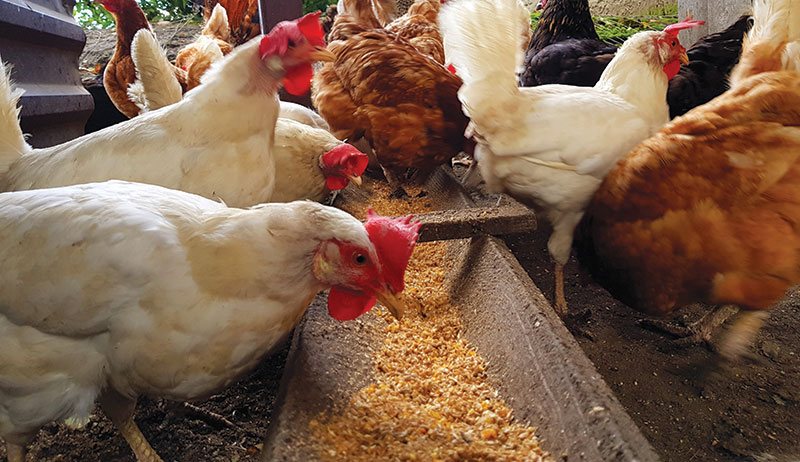Commercial chicken feed is a vital component in ensuring the health and productivity of your poultry. Understanding what grains are in commercial chicken feed can help you make informed choices for your flock. Many poultry enthusiasts may wonder about the specific ingredients included in these feeds. In this detailed article, we aim to provide a comprehensive overview of the various grains commonly used in commercial chicken feed.

The Importance of Grains in Chicken Feed
Why Grains are Essential for Poultry
Grains play a crucial role in the diet of chickens. They provide essential nutrients and energy needed for growth, egg production, and overall health. Not only are grains an important source of carbohydrates, but they also contain proteins, vitamins, and minerals necessary for maintaining a healthy flock.
Common Grains Used in Commercial Chicken Feed
Let’s delve into the common grains found in most commercial chicken feeds:

Corn: The Staple Grain
Why Corn is a Primary Ingredient
Corn is one of the primary grains used in chicken feed due to its high energy content and palatability. It’s easy for chickens to digest and is an excellent source of carbohydrates.
Benefits of Corn in Chicken Feed
Including corn in chicken feed helps in maintaining high energy levels in poultry. This grain supports steady growth and enhances egg-laying efficiency.

Wheat: A Versatile Grain
Nutritional Benefits of Wheat
Wheat is another common grain used in chicken feed. It provides a balanced amount of carbohydrates, proteins, and fibers, making it a nutritious addition to the diet of poultry.
Including Wheat in Your Chicken’s Diet
Wheat helps in improving the overall health of chickens and contributes to better egg quality.

Barley: Adding Fiber to the Mix
The Role of Barley in Chicken Feed
Barley is known for its high fiber content, which aids in the digestion process of chickens. Including barley in commercial feed can help in maintaining a healthy digestive system for your flock.
Health Benefits of Barley
The inclusion of barley helps in preventing digestive issues and supports nutrient absorption in chickens.
Sorghum: A Nutritious Alternative
Why Sorghum is Used in Feed
Sorghum is a grain that offers a rich source of energy and protein. It serves as an excellent substitute for corn, especially in regions where corn might be scarce or expensive.
Advantages of Sorghum
Sorghum is a cost-effective grain that provides essential nutrients, supporting growth and overall health in poultry.
Oats: For Added Nutritional Value
Nutrient Profile of Oats
Oats are included in commercial chicken feed for their high protein and fiber content. They are also a good source of essential fatty acids.
Benefits of Feeding Oats
Feeding oats to chickens can result in better feather quality and improved egg production.
Millet: A Protein-Rich Grain
Millet’s Nutritional Benefits
Millet is known for its high protein content and is often used in bird feed mixes. It’s a great addition to commercial chicken feed for enhancing the protein intake of your flock.
Why Include Millet?
Including millet helps in promoting healthy growth and development in chickens, making it a valuable grain in commercial feeds.
Rice: High-Energy Grain
The Role of Rice in Chicken Feed
Rice is an excellent source of energy and is often included in chicken feeds to provide a well-rounded nutritional profile.
Health Benefits of Rice
Adding rice to chicken feed helps in ensuring that poultry get a balanced diet, essential for optimal health and productivity.
Rye: Enhancing Digestive Health
Nutritional Value of Rye
Rye is included in commercial chicken feed for its beneficial effects on the digestive system. Its high fiber content aids in digestion and nutrient absorption.
Benefits of Rye in Chicken Feed
Feeding rye to chickens can help prevent digestive issues and support a healthy gut.
The Importance of Balanced Nutrition
Creating a Balanced Diet for Poultry
It’s crucial to provide a balanced diet to chickens to ensure their overall health and productivity. Combining various grains in commercial feeds helps in achieving this balance.
Ensuring Optimal Health and Productivity
A well-balanced diet enhances immunity, supports growth, and improves egg production in chickens.
Selecting the Right Commercial Feed
Factors to Consider When Choosing Feed
When selecting commercial feed, consider factors like the nutritional content, the age of your chickens, and their specific dietary needs.
Making Informed Choices
Understanding the grains included in commercial feed helps in making informed choices, ensuring your flock receives the best nutrition possible.
DIY Chicken Feed Mix
Creating Your Own Chicken Feed
Some poultry enthusiasts prefer to create their own chicken feed mix. By understanding the nutritional benefits of different grains, you can formulate a balanced and nutritious feed for your flock.
Benefits of DIY Feed Mix
Creating your own feed mix allows for customization based on your flock’s needs and helps in ensuring high-quality nutrition.
Conclusion: The Role of Grains in Commercial Chicken Feed
The various grains included in commercial chicken feed play a significant role in providing essential nutrients to your poultry. By understanding what grains are in commercial chicken feed, you can make informed decisions to ensure the health and productivity of your flock.
For more detailed information on poultry care, check out our Chicken Breed Eggs page, our Tasting Chicken Breeds page, and our Chicken Breed Longest page.
As an Amazon Associate, I earn from qualifying purchases.
Frequently Asked Questions
What grains are in commercial chicken feed?
Common grains in commercial chicken feed include corn, wheat, barley, sorghum, oats, millet, rice, and rye.
Why are grains important in chicken feed?
Grains provide essential nutrients, energy, and fiber, supporting growth, egg production, and overall health in poultry.
Can I create my own chicken feed mix?
Yes, you can create your own chicken feed mix by understanding the nutritional benefits of different grains and formulating a balanced diet for your flock.
For further information on alternative feeding options, you can visit Homesteading Family.









